What is the Most Heat-Tolerant Annual Flower? Discover the Top Picks for Your Garden
Are you tired of watching your garden wilt under the intense summer sun? Many gardeners struggle to find flowers that can thrive in extreme heat. Luckily, some flowers can withstand sizzling temperatures and still bloom beautifully.
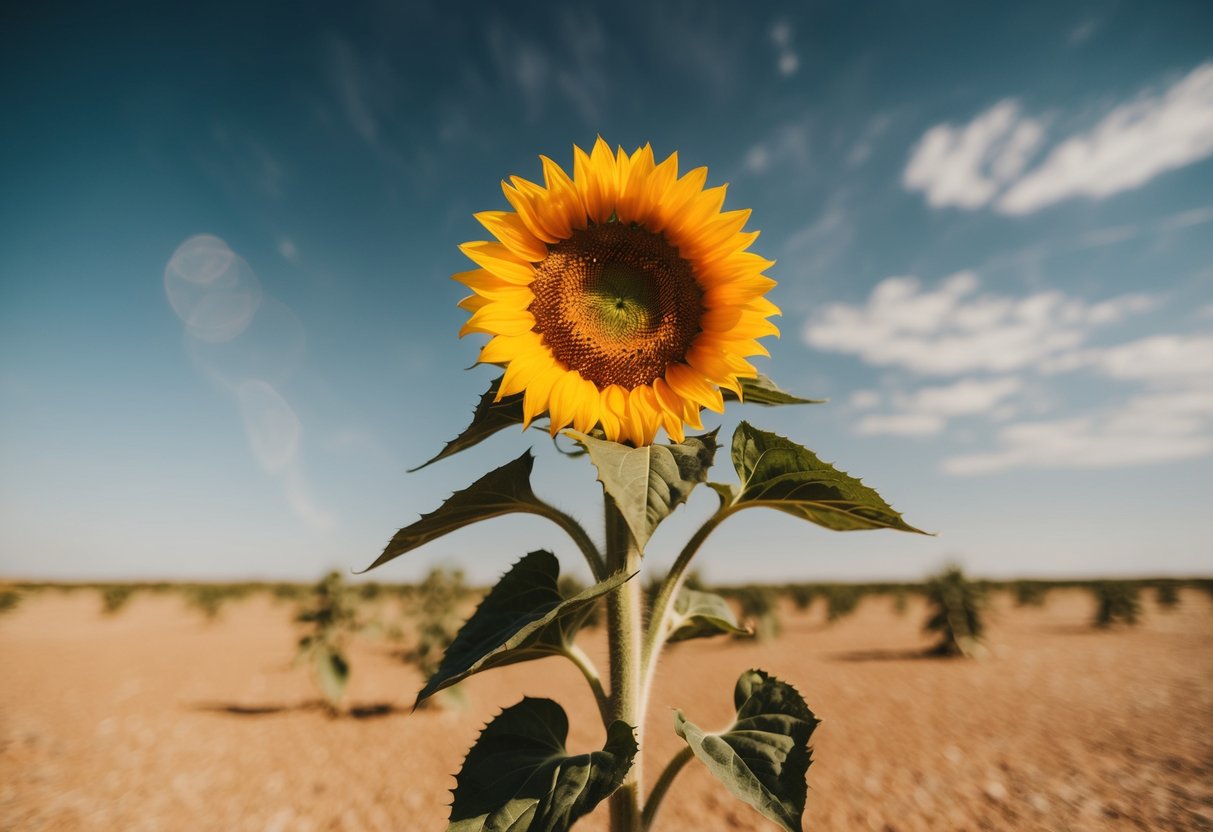
One standout option is the Mandevilla, a robust tropical vine known for its vibrant trumpet-shaped blossoms in shades of white, red, or pink. This plant is a perfect pick as it not only climbs and adds height to your garden but also resists wilting in the hot summer months. If you’re looking to fill your garden with color that won’t fade, this is a great choice.
Another contender is the Phlox, which can handle full sun and high temperatures while still producing stunning blooms. This flower is ideal for those sunny spots where other plants might struggle. Each of these flowers brings its own flair, ensuring your garden remains lively and enchanting all summer long.
Understanding Heat Tolerance in Flowers

Heat-tolerant flowers thrive in hot climates, providing beauty when other plants may struggle. It’s important to understand how these flowers survive high temperatures.
Defining Heat Tolerance
Heat tolerance in flowers means they can handle high temperatures without wilting. These plants have adapted to grow well even in intense sunlight and warm conditions. They often have thicker leaves or deeper root systems to retain water.
Choosing the right soil is key. Well-draining soil prevents roots from sitting in water, which can lead to rot. Sandy or loamy soils work best. Water requirements for heat-tolerant plants can vary, but many need less frequent watering due to their ability to store water efficiently.
Significance for Gardeners
For gardeners, choosing heat-tolerant plants is a smart move in hot areas. They require less maintenance as they’re built to withstand tough conditions. This means less frequent watering and fewer worries about heat waves.
Heat-tolerant plants include flowers like portulaca and salvia which thrive in summer heat. These plants also help in managing garden resources effectively. You save water and time, keeping your garden lush with less effort. They offer a beautiful garden all summer long without constant care.
Top Heat-Tolerant Annuals for Full Sun Exposure
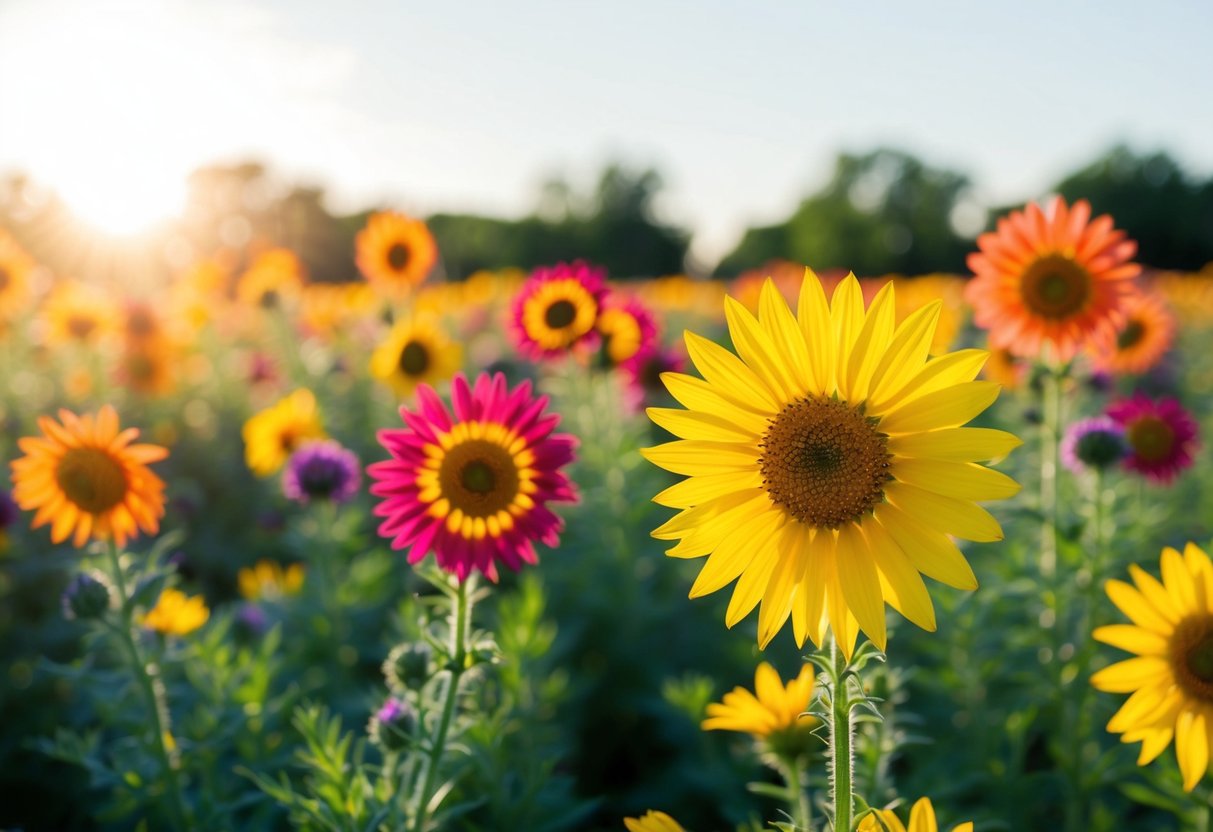
When selecting flowers for sun-drenched areas, focus on varieties that thrive in heat. These blooms bring vibrant colors to gardens and resist wilting in hot temperatures.
Lantana Camara
Lantana Camara is a great choice for sunny spots. It offers bright clusters of flowers in colors like orange, red, and yellow. You’ll love how it attracts butterflies to your garden. These flowers are well-suited to withstand heat and drought, making them perfect for full-sun areas.
Lantanas are easy to maintain, requiring little water once established. Whether in borders or containers, Lantana adds a tropical vibe to your space. Just ensure your soil is well-drained, as overly wet conditions can harm the plant.
Portulaca (Moss Rose)
Portulaca, commonly known as Moss Rose, is a sun-lover. Its rose-like blooms come in a wide array of colors including pink, yellow, and white. Ideal for hot climates, Portulaca thrives in this environment and graces gardens with blooms all summer long. Moss Rose is perfect for rock gardens or the edge of flower beds.
These flowers need minimal water, making them great for those wanting a low-maintenance garden. Make sure to provide well-draining soil, as they dislike standing water. With their ability to withstand high temperatures and bright sunlight, Portulaca is a hardy addition to any garden.
Zinnias
Zinnias are popular for their cheerful, daisy-like blooms in colors ranging from vibrant reds to soft pastels. They are fantastic for full-sun locations, growing quickly and blooming profusely. You’ll find that they attract butterflies, bringing life to your garden.
Zinnias can grow quite tall, often reaching heights of up to three feet. Plant them in well-drained soil and water them regularly for the best blooms. They are also resistant to heat, making them a reliable choice for gardeners battling high summer temperatures.
Marigolds
Marigolds are a classic choice for sunny gardens. These annuals produce bright red, orange, and yellow blooms, filling your space with color. Marigolds are known for their ability to repel certain garden pests, making them beneficial beyond just their appearance.
Their hardy nature means they can thrive in various conditions, including heat and full sun. Marigolds prefer well-drained soil and can tolerate dry conditions once established. They are also easy to grow from seed, providing an accessible gardening option.
Vinca (Periwinkle)
Vinca, or Periwinkle, offers glossy green leaves and delicate flowers in colors such as pink and purple. They are excellent for full-sun garden spots and have great heat tolerance. Superb for ground cover, Vinca spreads quickly and blooms all season long.
These plants demand little attention, thriving with occasional watering. Known for their resilience, Vinca withstands both heat and drought, making it a dependable addition to warm gardens. Just ensure good drainage to prevent root rot and keep your Vinca flourishing.
Caring for Heat-Tolerant Annuals
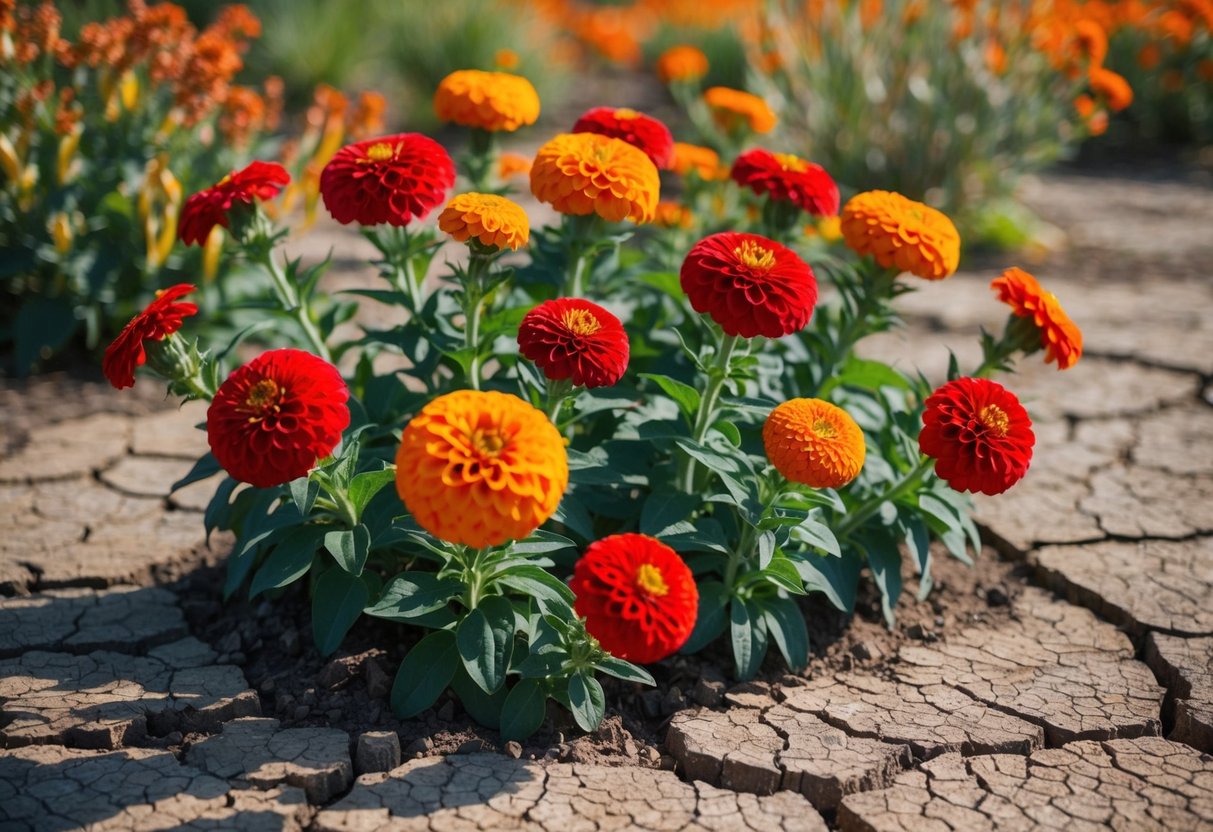
When growing heat-tolerant annuals, you need to focus on proper soil, watering, mulching, fertilization, and deadheading. Each plays a key role in maintaining healthy plants that can withstand high temperatures.
Soil and Watering Tips
Choose well-draining soil to ensure your plants thrive. This type of soil prevents water from pooling, reducing the risk of root rot. Mix in organic matter like compost or peat moss to improve soil texture and provide vital nutrients.
Watering these annuals deeply but infrequently promotes strong root systems. It’s best to water in the early morning, so the plants have time to dry before the heat of the day. Keep an eye on the soil moisture, and watch for signs of stress like wilting.
Mulching and Fertilization
Apply a layer of mulch around your plants to help retain moisture and regulate soil temperature. Mulch also suppresses weeds, which can compete for water and nutrients. Choose organic mulch options like straw, wood chips, or shredded leaves for best results.
Fertilization is important for ongoing plant health. Use a balanced, slow-release fertilizer that contains nitrogen, phosphorus, and potassium. Be cautious not to over-fertilize, as it can lead to excessive growth that’s hard to support in hot weather.
Deadheading for Continued Blooms
Deadheading helps keep your annuals blooming throughout the season. This process involves removing spent flowers, which encourages the plant to produce more blooms. Use sharp scissors or garden shears to make clean cuts just above a leaf node.
Make deadheading a regular part of your gardening routine. Not only does it promote more flowers, but it also keeps your plants looking tidy. Be gentle when handling the plants to avoid damaging any new buds or growth. Regular attention to this task ensures a vibrant garden all summer.
Designing With Heat-Loving Annuals
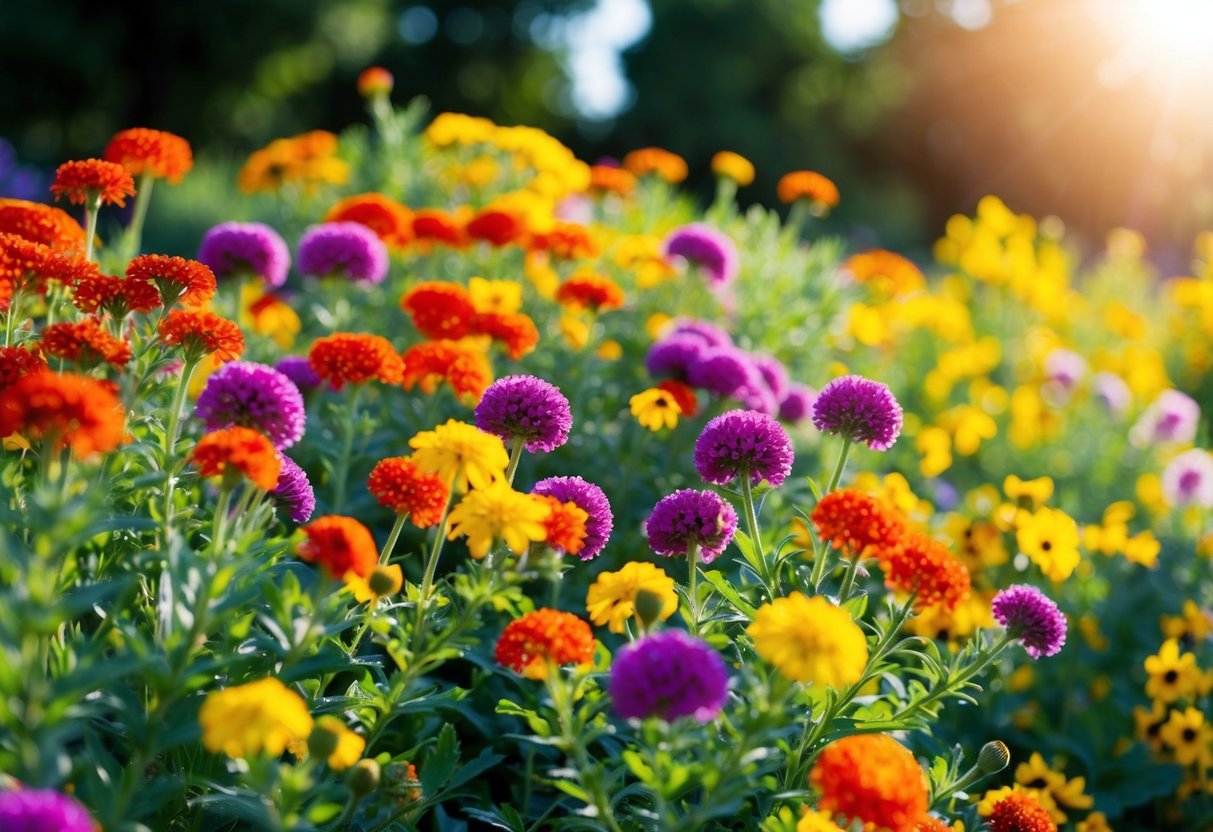
When working with heat-loving annuals, focus on creating a vibrant and dynamic garden. Consider the color palette, plant heights and textures, and going for container gardening for versatile designs.
Choosing the Right Color Palette
Selecting the right colors is crucial for a lively garden. Heat-loving annuals offer a range of vibrant colors. Think about combining bright reds, oranges, and yellows for a warm, sunny feel. Cool blues and purples can balance these hot shades, creating a pleasing contrast.
In flower beds, use a mix of annuals like Angelonia and Ageratum that continue to bloom throughout the summer, ensuring continuous color. Mixing colors wisely can attract attention and make your garden the talk of the neighborhood.
Balancing Plant Heights and Textures
Varying plant heights and textures can add depth to your garden. Consider low-growing annuals like Phlox that spread across the ground, paired with taller plants like Angelonia. This mix creates a layered look, making your garden more visually appealing.
Texture also plays a role. Use fine-textured plants for a delicate appearance and coarser plants for bold statements. This variety adds interest to flower beds and prevents your garden from appearing flat. Experimenting with different combinations can enhance your outdoor space significantly.
Annuals for Container Gardening
Container gardening provides flexibility in design and placement. Containers can brighten patios or entryways with heat-tolerant annuals such as Ageratum and Coneflower. Choose containers that complement the color and style of your plants for a cohesive look.
Using a mix of upright and trailing plants creates a fuller effect, drawing the eye and adding dimension. Make sure your containers have proper drainage to prevent waterlogging. Containers are perfect for small spaces or urban gardens, allowing you to experiment with different arrangements easily.
Attracting Pollinators with Heat-Tolerant Annuals
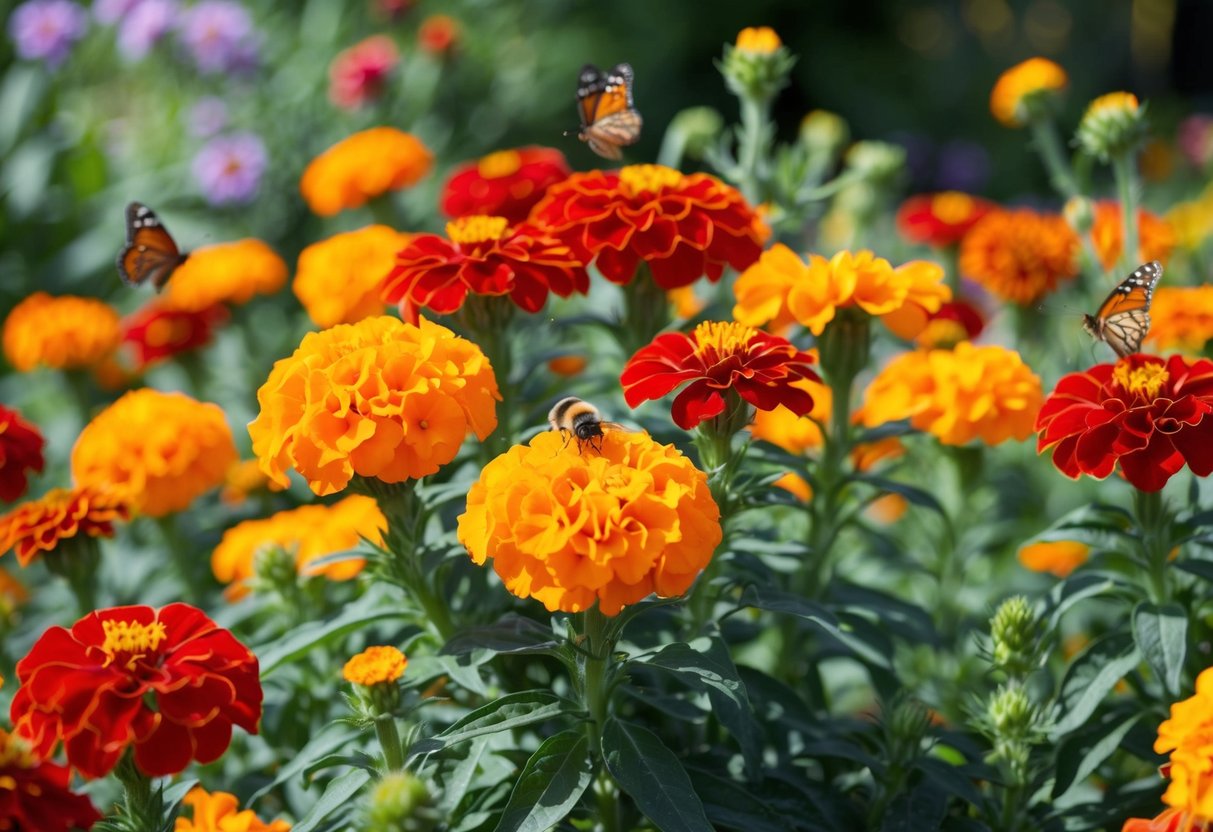
Choosing the right heat-tolerant annual flowers can boost your garden’s ability to attract pollinators. This not only enhances the beauty of your space but also supports vital ecosystems.
The Best Flowers for Attracting Pollinators
In hot climates, certain plants thrive while also drawing in pollinators. Sunflowers are a top choice. They bloom throughout the summer and are known for attracting bees and butterflies with their bright yellow faces. The Suncredible® Yellow Helianthus mix is particularly appealing.
Zinnias are another excellent option. These vibrant flowers come in various colors and are loved by butterflies. They’re easy to grow and do well even in hot, sunny spots. Consider adding Salvia to your garden, a plant praised for its tall spikes and ability to bring in hummingbirds, bees, and butterflies from spring through fall.
Creating a Pollinator-Friendly Garden
To make your garden inviting for pollinators, start by planting in clusters. Grouping plants helps pollinators find and feed on the flowers more easily.
Choose a mix of colors and flowering times to ensure a continuous bloom throughout the season.
Include water sources like shallow birdbaths or damp soil spots. These provide hydration for bees and butterflies.
Avoid using pesticides, as these can harm your garden’s visitors. Instead, use natural alternatives to keep pests at bay.
Create a mix of plants that bloom at different rates. This will maintain an ongoing food supply for your pollinators.
Embrace diversity by incorporating a variety of flowers, as this creates a more attractive and functional garden space.







